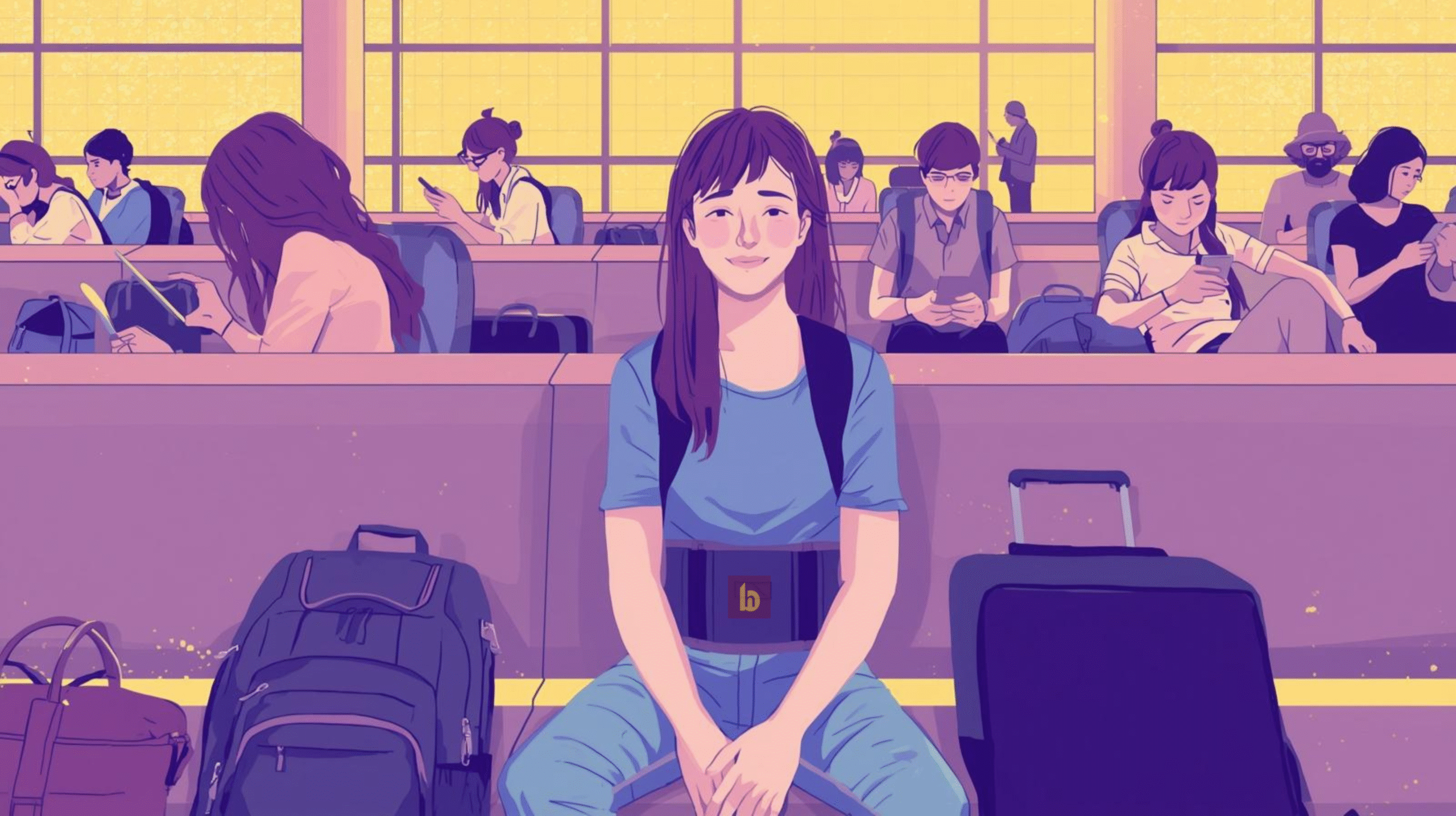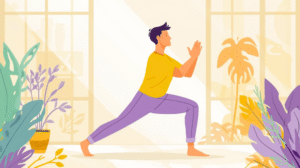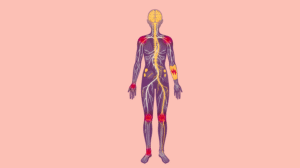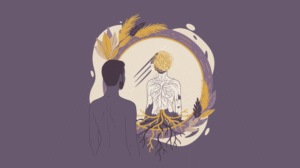Let’s picture this: You’re stepping in the plane, excited for a beach escape or maybe a family reunion, you’ve got everything you need; snacks, charger, maybe even that trendy neck pillow. Fast forward a few hours and instead of walking off the plane feeling excited, your back hurts like it has just survived a mini rollercoaster. Your shoulders slumped, spine screaming for mercy and suddenly the vacation vibe felt slightly less glamorous.
Turns out, the real turbulence isn’t outside the window, it’s in your spine. Long journeys do more damage than we realize. Hours of sitting still in cramped buses, road trips in poorly designed car seats or endless flights silently wear down your posture alignment [1], which often results in chronic back pain, fatigue and muscle stiffness.
Now, here’s a subtle little trick savvy travelers swear by: a posture corrector belt, a small lightweight tool, easy to slip on under clothes. It gently nudges your shoulders back, reminds your spine to sit tall, and reduces fatigue.
Think of it as your back’s low-key travel buddy, no magic, just comfort and smart support. In this article, we’ll discover how a simple travel hack like a right posture corrector helps you to stay upright, pain free and energised while traveling.
Is Travel Actually Aging Your Back Faster Than You Think?
How Hours of Sitting Compress Your Spine?
Here’s the not-so-fun truth: every hour you stay glued to your seat, your spine takes the hit. Gravity pushes down, your discs get less cushiony, and the muscles that usually hold everything in place start to doze off [2]. That’s why long flights or road trips leave you feeling like your back has gone a few rounds in the ring.
The Sneaky Link Between Posture, Fatigue, and Mood
Ever notice how slouching makes you feel not just sore, but drained? Poor posture actually squeezes your lungs, which means less oxygen and more sluggish vibes. Studies even suggest that slouching can lower your mood [3]. So it’s not just your back that suffers, it’s your whole travel mood board.
Why Even Young Travelers Feel “Old” After Long Trips?
You don’t need gray hair to groan when getting out of a plane seat. Bad posture accelerates musculoskeletal fatigue across all ages, which is why even young travelers often feel stiff and achy after long rides [4].
What Travel Mistakes Quietly Destroy Your Posture?
Using Gadgets Nonstop Without Support (Hello, Tech-Neck)
Binge-watching shows mid-flight? Scrolling endlessly on your phone? That forward tilt of the neck increases pressure on your cervical spine [5]. A shoulder posture corrector for sitting helps counter this by pulling your shoulders back.
Ignoring Lumbar Support in Car Seats and Buses
Most travel seats are built to fit in as many people as possible but not to actually support your back. That’s why, after a few hours, your lower back starts rounding and grumbling in protest. A simple fix? Add a little extra support. A lumbar cushion on road trips or even a posture corrector belt can step in where the seat fails, giving your spine the comfort it deserves.
Trusting Flimsy Seat Designs to Do the Job
Here’s a joke with a truth bomb: if travel seats were ergonomic, chiropractors would go broke. Seats are often flat, rigid, and unsupportive, putting all the pressure on your spine [6].
Why Do Popular Fixes Fail (and Sometimes Make Things Worse)?
Neck Pillows: Great for Naps, Bad for Posture
They cradle your head for sleep but don’t fix spinal misalignment. Many travelers wake up with stiff necks despite using them.
Painkillers and Coffee: Quick Fixes, Long Regrets
Sure, a pill or cup of coffee masks the discomfort, but they don’t correct posture. Worse, they can encourage pushing through strain, worsening the problem [7].
DIY Tricks (Like Rolled-Up Sweaters) That Don’t Hold Up
Stuffing a sweater behind your back helps for five minutes until it flattens. Real support requires tools designed for alignment.
So, What Makes the Posture Corrector Belt the Ultimate Travel Ally?
Trains Your Spine to Sit Upright Without Extra Effort
Unlike quick hacks, the belt gently pulls your shoulders back, training your muscles to remember correct posture over time [8]. That’s why many travelers find it a long-term solution, not just a Band-Aid.
Adjustable Straps Make It Fit Everyone Comfortably
An adjustable travel posture belt means no more “one-size-fits-nobody” problems. Whether you’re petite or broad-shouldered, you can customize the fit.
Slim, Lightweight, and Discreet Under Clothing
Modern belts are designed to slip easily under clothing. A lightweight posture corrector for journeys won’t bulk up your carry-on or ruin your travel outfit [9].
Belt or Shoulder Strap: Which One Should You Pack in Your Carry-On?
Traveling light is an art, but when it comes to your posture, the right support tool can make or break your journey. Whether you’re squeezing into an airplane seat or clocking hours behind the wheel, knowing the difference between a posture corrector belt and a shoulder strap can help you choose the perfect travel companion.
Posture Corrector Belt for All-Round Back and Lumbar Support
Think of the posture corrector belt as your foundation, it’s built for the long haul. By wrapping around your core and stabilizing your lumbar area, it helps you maintain proper alignment, especially during hours of sitting. On road trips or long drives, this belt doesn’t just reduce strain but also keep you from collapsing into that all-too-familiar slouch. The result? A more upright spine, less stiffness when you finally stretch your legs, and a back that feels supported instead of strained.
Shoulder Posture Corrector for Upper-Body Strain
Now, if your biggest complaint is a stiff neck or rounded shoulders after travel, the shoulder posture corrector might be your go-to. Designed to gently pull your shoulders back, it relieves tension in the upper body and helps you sit straighter without hunching over. It’s especially useful if you spend flights or bus rides scrolling on your phone or reading, where the “forward head” position sneaks in and leaves you sore by the time you land.
Why Frequent Travelers Often Use Both?
Just like you wouldn’t pack only sneakers or only flip-flops, posture correction tools work best when you have options. Many frequent travelers keep both in their carry-on and switch depending on the journey. Long car ride ahead? The belt has your back. Quick flight with lots of reading or laptop use? The shoulder strap takes the strain off your neck and shoulders. Together, they cover the full range of posture pitfalls so you can focus on the trip, not the aches.
What Other Smart Travel Gadgets Save Your Spine?
Portable Lumbar Cushions That Fill Those Seat Gaps
Ever notice how seats always leave that awkward gap at your lower back? That’s where a memory foam or ergonomic lumbar cushion slips right in, they support the natural curve of your back, giving your spine the support it craves during long rides.[10]
Compact Neck Pillows That Actually Help
Forget the oversized, floppy ones. A contoured neck pillow hugs your neck gently, keeping your head aligned so you don’t wake up with a stiff “travel hangover.”
Smart Posture Reminders and Travel-Friendly Fitness Apps
Tiny buzzes when you slouch or quick stretch prompts from an app can be game-changers. They’re like having a friendly coach reminding you to sit tall without nagging.
Can You Actually Fix Bad Posture While on the Move?
Simple Seat Hacks for Flights and Drives
Keep both feet flat, recline slightly to reduce disc pressure, and use a small pillow to maintain the natural lumbar curve.
Discreet Posture Stretches You Can Do Without Standing
Shoulder shrugs, chin tucks, and seated twists can all be done mid-flight or during pit stops [11].
Micro-Habits That Keep Posture Strong After the Trip
Drink water, take walking breaks, and use posture check-ins on your phone. Over time, these habits keep your spine healthier than any souvenir.
Real People, Real Journeys: Do Belts Make a Noticeable Difference?
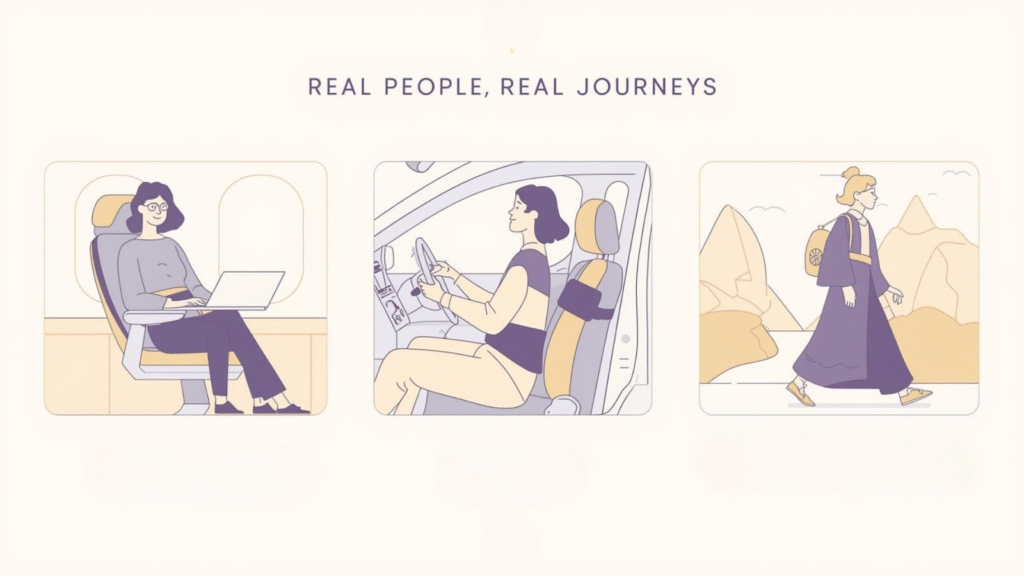
The Freelancer Who Works Mid-Flight Without Back Pain
Rina, a digital nomad, started using a posture corrector belt on flights. She now lands refreshed and can start work immediately instead of nursing stiffness.
The Long-Distance Driver Who No Longer Dreads the Highway
Raj, a cab driver, paired his belt with lumbar cushions. His fatigue dropped dramatically, and he no longer ends shifts with a sore back.
The Pilgrim Who Finally Completed a Journey Pain-Free
Anita, on a multi-day pilgrimage, wore a lightweight belt daily. For the first time in years, she completed her journey without severe back pain.
Should Good Posture Really Be a Travel Priority in 2025?
Rising Rates of Back Pain Among Travelers Worldwide
Research shows low back pain is the world’s leading cause of disability, and frequent travel makes it worse [12].
Posture as a Hidden Factor in Confidence and Energy
Good posture isn’t just about avoiding pain—it helps you breathe better and even appear more confident .
Why Should Belts Be Normalized Like Neck Pillows ?
If neck pillows are travel essentials, why not posture belts? They’re discreet, portable, and far more effective in protecting your spine.
Conclusion: Why Does Your Spine Deserve a Boarding Pass Too ?
Travel is meant to recharge you, not leave you sore and slouched. The hidden villain of every trip is poor posture. It can age your back, zap your energy, and dampen your mood.
The solution doesn’t have to be complicated. A posture corrector belt is a small, game-changing tool that keeps you upright, comfortable, and ready to explore.
So, pack light, sit right, travel bright. Your spine deserves a boarding pass too.
Explore More Health & Wellness Solutions
Want to stay informed about wellness and everyday health issues? Here are some insightful reads to guide you. Explore the links below for practical tips and solutions:-
- https://betterhood.in/learn/how-pelvic-alignment-affects-lumbar-spine-health
- https://betterhood.in/learn/posture-problems-in-the-real-world/
- https://betterhood.in/learn/ergonomic-hacks-for-frequent-ride-share-drivers/
- https://betterhood.in/learn/how-seat-angle-affects-your-spine-on-long-drives/
- https://betterhood.in/learn/adjustable-vs-fixed-car-backrests/
Frequently Asked Questions
1. Do posture corrector belts actually work during long flights?
Yes. They reduce slouching, support spinal alignment, and minimize fatigue during long flights.
2. Can I wear a posture belt under clothes without discomfort?
Absolutely. Modern designs are slim, discreet, and comfortable under most clothing.
3. Which is better for travel– a back support belt or shoulder posture corrector?
It depends. Back belts support lumbar regions, while shoulder correctors ease upper-body strain. Many travelers use both.
4. How long can I wear a lightweight posture corrector for journeys safely?
Experts recommend 2–3 hours at a stretch, with breaks in between to maintain circulation.
5. Are posture corrector belts portable enough for carry-on travel?
Yes. They fold flat, weigh little, and easily fit into carry-ons.
6. Do belts help with road trip fatigue and long sitting hours?
Yes. They stabilize posture, reduce lower back pressure, and help prevent fatigue from long drives.
References
- Sharafkhani, M., Argyle, E., Cobb, S., Tennent, P., Vink, P., Frohriep, S., Mansfield, N., Naddeo, A., & Jacobs, K. (2021). Posture, movement, and aircraft passengers: An investigation into factors influencing in-flight discomfort. Work, 68(1), 7-18. https://journals.sagepub.com/doi/abs/10.3233/WOR-208016?utm_source=chatgpt.com
- Bridger, R. S., & Morris, D. (2017). Lumbar disc changes associated with prolonged sitting [PMC article]. Spine more detail (journal). https://pmc.ncbi.nlm.nih.gov/articles/PMC4152382/?utm_source=chatgpt.com
- Wilkes, C. (2017). Upright posture improves affect and fatigue in people with mild-to-moderate depression. Journal of Health Psychology, 22(9), 1151–1158.https://pubmed.ncbi.nlm.nih.gov/27494342/
- Pacheco, M. P., Carvalho, P. J., Cavalheiro, L., & Sousa, F. M. (2023). Prevalence of postural changes and musculoskeletal disorders in young adults. International Journal of Environmental Research and Public Health, 20(24), 7191. https://doi.org/10.3390/ijerph20247191
- Kim, M. S. (2015). Influence of neck flexion angle on cervical muscle activity. Journal of Physical Therapy Science, 27(3), 977–979. https://doi.org/10.1589/jpts.27.977
- McGill, S. M., & Fenwick, C. M. (2009). Using a pneumatic support to correct sitting posture for prolonged periods: A study using airline seats. Ergonomics, 52(9), 1162–1168. https://doi.org/10.1080/00140130902936067
- Derry, C. J., Derry, S., & Moore, R. A. (2014). Caffeine as an analgesic adjuvant for acute pain in adults. Cochrane Database of Systematic Reviews, 2014(12), CD009281. https://doi.org/10.1002/14651858.CD009281.pub3
- Rodriguez, T. (2021, March 9). Do posture correctors work? Expert advice from a PT. Hospital for Special Surgery. https://www.hss.edu/health-library/move-better/do-posture-correctors-work
- Chung, J., Tang, W., Yoon, J. E., Ha, S., & Kang, J. Y. (2024). Design guidelines for movement-assistive clothing based on a comprehensive understanding of older adults’ needs and preferences. PLOS ONE, 19(3), e0299434. https://doi.org/10.1371/journal.pone.0299434
- Everlasting Comfort. (2020, July 5). Office ergonomics: Why you need a memory foam seat cushion. https://everlastingcomfort.com/blogs/comfy-reads/memory-foam-seat-cushion
- Kaiser Permanente. (n.d.). Exercising while sitting down. https://healthy.kaiserpermanente.org/health-wellness/health-encyclopedia/he.exercising-while-sitting-down.abl0337
- Institute for Health Metrics and Evaluation (IHME). (2023, May 22). New study shows low back pain is the leading cause of disability globally. https://www.healthdata.org/news-events/newsroom/news-releases/lancet-new-study-shows-low-back-pain-leading-cause-disability
